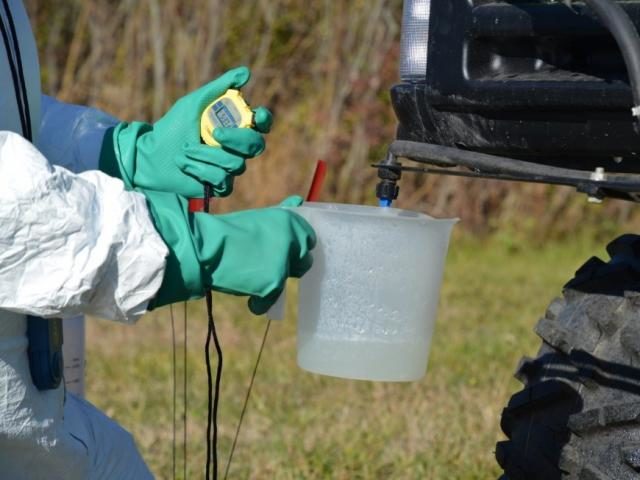By Erdal Ozkan, Professor of Agricultural Engineering
This is the time to check the accuracy of your sprayer. While applying too little pesticide may result in ineffective pest control, too much pesticide wastes money, may damage the crop and increases the potential risk of contaminating ground water and environment. The primary goal with calibration is to determine the actual rate of application in gallons per acre, then to make adjustments if the difference between the actual rate and the intended rate is greater or less than 5% of the intended rate. This is a recommended guideline by USEPA and USDA.
I get this question all the time: “Why should I calibrate my sprayer? I have a rate controller on the sprayer. I just enter the application rate I want, the controller does the rest”. This statement is correct, only if you are sure about the accuracy of the rate controller which is highly affected by the accuracy of the sprayer travel speed data that goes in the rate controller. If the speed is determined by a sensor that measures the revolution of the tractor rear wheels, the travel speed calculated may not be accurate for several reasons: such as the tire pressure being low (causing a smaller tire rolling radius), or the ground conditions that may cause tire slippage (such as wet ground, or soft, sandy soil). So, it is always a good idea to do a manual calibration of the sprayer and compare the actual application rate with what is displayed on the rate controller. In addition, a rate controller may not pinpoint a plugged, or worn out nozzle on the boom. Overall, you may get the desired gal/acre application rate, but you may not have the uniform application across the boom unless you check all the nozzles individually. That is also a part of the calibration, as well as finding out the application rate. Clean all the plugged nozzles. Check the output of all the nozzles for a given length of time at a given spray pressure. Compare the measured output from each nozzle with the expected output of a brand new nozzle shown in the nozzle catalog for the same spray pressure. Replace the nozzles showing an output error of more than 10% of the output of the new nozzle. Once you do all this, now you are ready to calibrate your sprayer.
There are several ways to calibrate a sprayer. Regardless of which method you choose, it usually doesn’t take more than 30 minutes, and only three things are needed: a timer (or watch or smart phones) showing seconds, a measuring tape, and a jar graduated in ounces. Here, I will describe perhaps the easiest of all the methods to determine the actual application rate of a sprayer for broadcast applications:
- Fill the sprayer tank (at least half full) with water.
- Run the sprayer, inspect it for leaks, and make sure all vital parts function properly.
- Measure the distance in inches between the nozzles.
- Measure an appropriate travel distance in the field based on this nozzle spacing. The appropriate distances for different nozzle spacing is as follows: 408 ft for a 10-inch spacing, 272 ft for a 15-inch spacing, 204 ft for 20-inch spacing, 136 feet for a 30-inch spacing, and 102 feet for a 40-inch spacing. (See extension publication FABE-520 for travel distances for other spacings, and for an explanation for selection of these specific travel distances for given nozzle spacing (http://ohioline.osu.edu/factsheet/fabe-520)
- Drive through the measured distance in the field at your normal spraying speed, and record the travel time in seconds. Repeat this procedure and average the two measurements.
- With the sprayer parked, run the sprayer at the same pressure level and catch the output from each nozzle in a measuring jar for the travel time required in step 5 above.
- Calculate the average nozzle output by adding the individual outputs and then dividing by the number of nozzles tested. The final average nozzle output in ounces you get is equal to the application rate in gallons per acre. For example, if you catch 15 ounces from a set of nozzles, the actual application rate of the sprayer is equal to 15 gallons per acre.
- Compare the actual application rate with the recommended or intended rate. If the actual rate is more than 5 percent higher or lower than the recommended or intended rate, you must make adjustments in either spray pressure or travel speed or in both. For example, to increase the flow rate you will need to either slow down, or increase the spray pressure. The opposite is true when you need to reduce application rate. As you make these changes stay within proper and safe operating condition of the sprayer. Remember increased pressure will result in increasing the number of small, drift-prone droplets. Using the trial-and error method to eventually reach the intended application rate takes some time. If you follow the equations given in Extension Publication FABE-520 on Calibration you can find optimum travel speed and pressure much faster.
- Recalibrate the sprayer (repeat steps 5-8 above) until the recommended application error of +5% or less is achieved.
Don’t forget one very important thing while calibrating, and especially operating a sprayer: safety. Although clean water is used during calibration, you should still protect yourself from getting in contact with pesticides inside or outside sprayer equipment. Wear personal protective equipment, at least gloves and goggles. Happy spraying!






